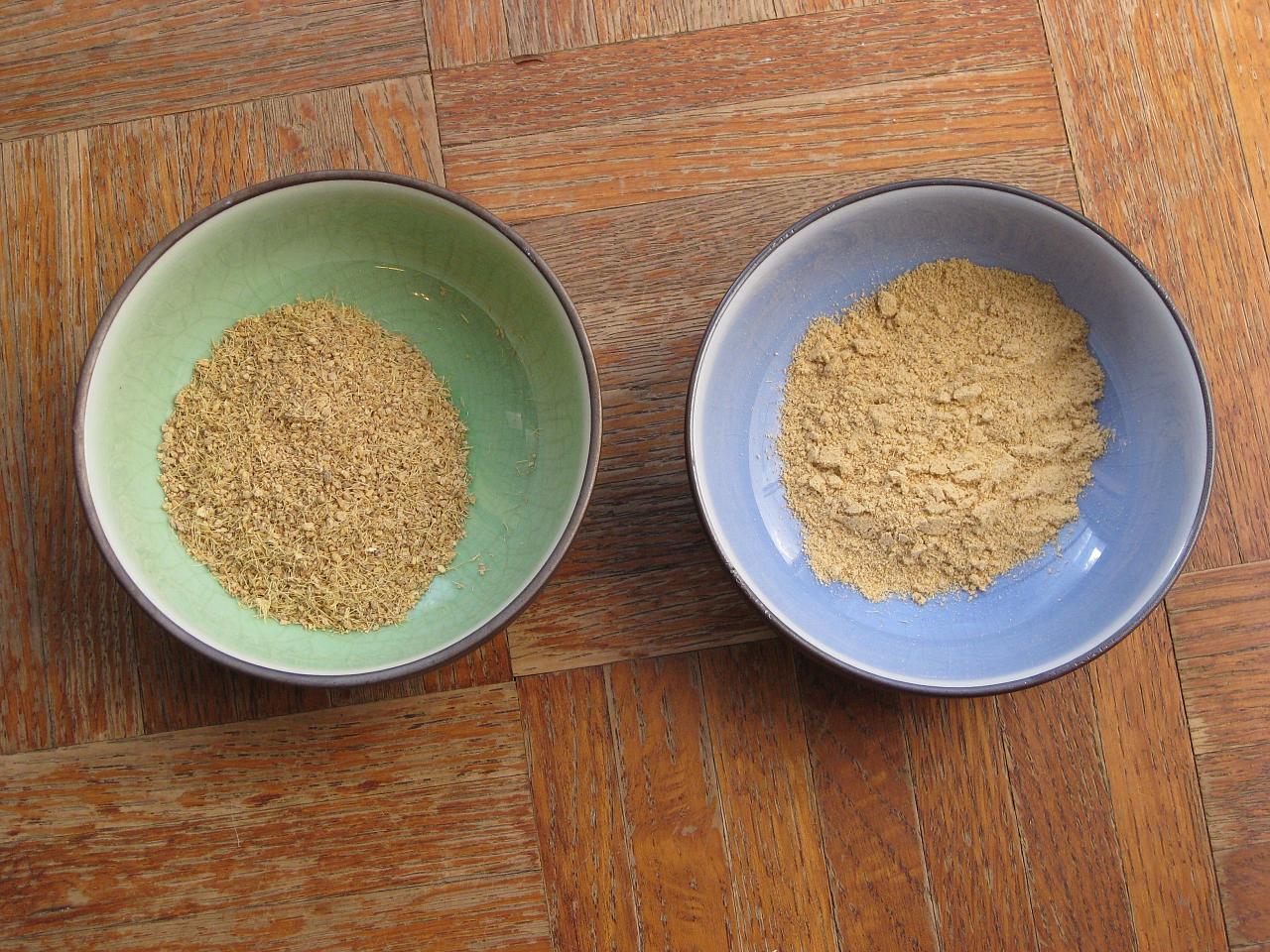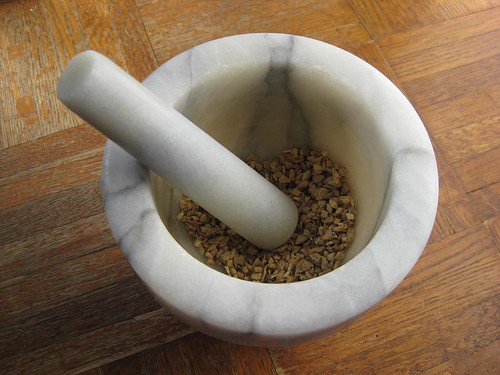I have been researching historical gingerbread lately, for a probable book project on nineteenth-century American cooking. The first part of the research involves cataloguing recipes. So far I have thirty-eight recipes for gingerbread published in the United States prior to 1832, all neatly stored in a database and assigned appropriate metadata. Don’t panic: I’m not going to tell you all about the metadata. I’m going to tell you about spices.
As a cultural historian I’m interested in the deeper meanings and broader implications of everything, and I know that often people eat what they eat and cook the way they cook because of tradition or philosophy or politics. But as a cook and a craftsman I know that sometimes people have more practical reasons for doing things that are almost impossible to discover unless you actually try to do them. I’m interested in not just inner feelings and amorphous notions but in the sounds and smells and tastes that were the fabric of life in other times and places, the constant movements and sensations without which culture is just a topic for anthropological discourse. It seems to me that if you want to research the history of food, you need to get in the kitchen.
So I started baking gingerbread.
The first recipe I tried was “Gingerbread Cakes, or butter and sugar Gingerbread” from Amelia Simmons’ 1796 American Cookery, the first cookbook written by an American for Americans. It’s notwithstanding a very English recipe, and I’ll blog more about it later (including an adaptation for modern kitchens). Making Miss Simmons’ gingerbread cakes has been a bit of an adventure. Here’s the recipe:
Three pounds of flour, a grated nutmeg, two ounces ginger, one pound sugar, three small spoons pearl ash dissolved in cream, one pound butter, four eggs, knead it stiff, shape it to your fancy, bake 15 minutes. American Cookery, p. 36.
You’ll notice she doesn’t say anything about technique — you were supposed to know what to do with the ingredients and how the cakes would turn out — but the first problem in reconstructing this recipe is the ingredients themselves. I’d never heard of pearl ash, and even the flour turned out to be problematic, but let’s start with the ginger.
Two ounces of ginger is a lot of ginger. I made test batches a quarter of the size of the original, so I needed half an ounce of ginger. Easy enough to reach for the jar of ground ginger on the spice rack, but half an ounce of ground ginger is about a quarter cup — and this was for only two and a half cups of flour. Some recipes call for more, a full ounce of ginger per pound of flour. This makes a cake that’s redolent of ginger, with a bouquet that grabs you by the sinuses and an afterburn like the mustard on a Chinese-restaurant eggroll. Was I really doing this right?
In 1796 “ginger” meant a dried knob of ginger — like the fresh ginger you buy in the grocery store today, but dried, because without controls on temperature and humidity you can’t keep ginger fresh all the way from Asia to Boston on a sailing ship. Some recipes call specifically for “pounded ginger,” which tells you what to do next: You literally pound it to powder with a pestle in a mortar.
I had some cracked dried ginger around, which had been sitting in a sealed plastic bag in the cupboard for nearly two years since I bought it by mail-order to use in making pickles. I figured that, old as it was, it might reasonably approximate in pungency the dried ginger available to the typical New England housewife of 1796. I made the assumption (unwarranted, but you have to start somewhere) that two ounces would have been weighed before pounding, not after, so I weighed out an ounce of cracked ginger on the kitchen scale, turned it into the mortar, and started pounding.
And pounding.
After about five minutes I sifted it through a metal strainer to see what I had. I felt justified in doing this because gingerbread recipes from the early nineteenth century occasionally called for “ginger, pounded and sifted,” and although a scrap of an old linen shirt would have made a more historically accurate sifter, my machine-made shirts are too finely woven to sift anything. The wire mesh worked fine, but I’d pounded only about half the ginger into powder. I turned the chunky portion back into the mortar and resumed pounding. And I do mean pounding, by the way, not the easy round-and-round grinding motion you can use to crush up more fragile spices. Literally pounding.
And pounding.
After another three or four minutes I sifted again and found I’d pounded about half of that batch to a fine powder. The rest went back into the mortar for a few minutes more, and again I’d pounded about half the remainder to powder. After that I didn’t get much out of it. I had six tablespoons of powdered ginger and a few tablespoons of crusty bits and threads that, were I a frugal eighteenth-century housewife, I’d save for medicinal tea. The powder was about as fragrant as from a fresh jar of McCormick’s, which tells you something about the shelf life of ground spices. But all this took me something over twelve minutes, and that was for only half a batch of Amelia Simmons’ ginger cakes.

An ounce of cracked dried ginger and twelve minutes’ vigorous pounding yielded six tablespoons of powdered ginger, some of which is in the blue bowl at right. The remnants in the green bowl will make a fine tea to ease your next bout of dyspepsia.
What did I learn from all this?
One, gingerbread is a lot of work, and I hadn’t even turned on the oven yet. This is why people had children, of course, to keep them occupied with menial tasks like this. You want gingerbread? Here, kid, start pounding.
Two, Americans two hundred years ago loved their ginger. Today gingerbread means a cookie or cake sweetened with molasses and faintly fragrant of spice; you’re lucky to find a recipe that calls for more than a teaspoon of ginger. A tablespoon would be considered shockingly spicy. But four to six tablespoons per pound of flour? Even if your ginger is stale, that’s a lot of spice. We’re talking gingerbread.
Historians have traditionally argued that medieval Europeans paid so much blood and treasure for spices because their food was often rotten and they needed the spices to make it palatable. Certainly rancid meat and mildewed flour need all the help they can get, but I’ve never felt this explanation was entirely adequate — and besides, if gingerbread was a treat, not daily bread, wouldn’t you use the best-quality ingredients you had? And if masking moldy flour was the goal, why not spread the spice more thinly, rather than blowing it out all at once?
One possibility is that people were surrounded by strong aromas, and it took a lot of spice to compete with the olfactory milieu. As my wife pointed out while enduring my fourth batch of gingerbread cakes, people in 1796 did not bathe daily; their houses were full of wood smoke; cows, pigs, and chickens roamed (and crapped in) the yard. And, in winter, people may have suffered from near-constant colds and sinus ailments that blocked much of that domestic bouquet, along with everything else. Only as people began sanitizing their environments would — could — their tastes have become more “refined.”
I need to think on this some more. In the meantime, it is back to the kitchen, and I’ll post a modern translation of Miss Simmons’ gingerbread cakes soon.
